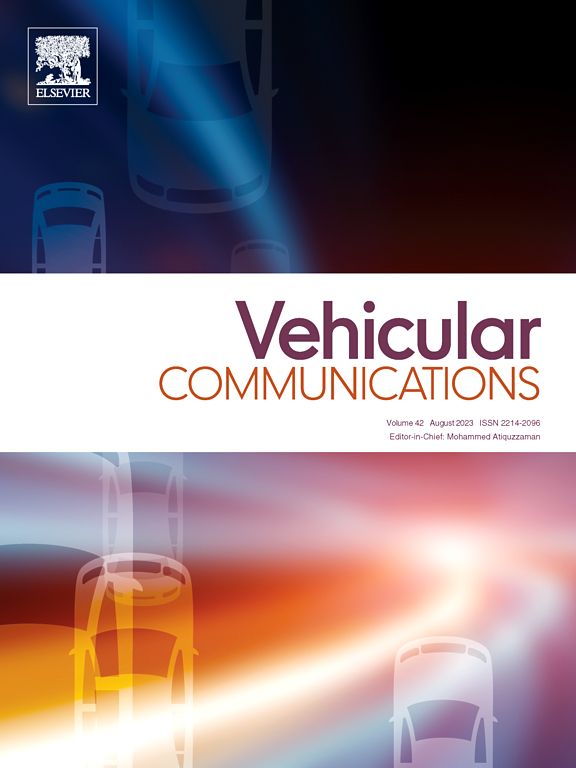Joint smooth trajectory design and wireless communication control for mobile internet of vehicles assisted by a UAV and ground RISs
IF 6.5
2区 计算机科学
Q1 TELECOMMUNICATIONS
引用次数: 0
Abstract
Low latency, reliable, and stable communication are essential for autonomous driving and mission accomplishment of Internet-of-Vehicles (IoVs) in smart cities. Therefore, future wireless networks will work based on quasi-optic millimeter wave (mmWave) signals for high-rate data transfer. However, given the mobility of vehicles, the mmWave links are prone to outages as they intrinsically rely on directional beamforming to line-of-sight (LoS) paths. Notably, fragile wireless links in dense urban canyons expose autonomous vehicles to safety risks. An unmanned aerial vehicle (UAV) equipped with a reconfigurable holographic surface (RHS) is navigated for establishing aerial LoS links for IoVs. RHS performs beamforming by adjusting the radiation patterns through the holographic surface, so it is energy efficient. The UAV-RHS is supported by terrestrial reconfigurable intelligent surfaces (RISs) installed on building facades, which are utilized to improve coverage and link reliability. The UAV’s navigation objectives are maintaining valid LoS links for IoVs, ensuring quality of service, and minimizing energy consumption. However, an obstacle-free kinematics-aware smooth trajectory, subject to motion constraints, is required for UAV navigation in dense urban environments. Satisfying these navigation objectives and constraints makes the trajectory design with valid LoS links a non-convex NP-hard optimization problem. To address this, we propose, for the first time, training generative adversarial networks (GANs) to generate valid paths in real time. State feedback control with quadratic optimization is proposed to smooth the trajectory. Simulation results are provided to evaluate the proposed method.
无人机与地面RISs辅助下的移动车联网联合平滑轨迹设计与无线通信控制
低延迟、可靠、稳定的通信是智慧城市中自动驾驶和车联网任务完成的必要条件。因此,未来的无线网络将基于准光毫米波(mmWave)信号进行高速数据传输。然而,考虑到车辆的移动性,毫米波链路很容易中断,因为它们本质上依赖于定向波束形成到视线(LoS)路径。值得注意的是,在密集的城市峡谷中,脆弱的无线链路使自动驾驶汽车面临安全风险。一种配备可重构全息面(RHS)的无人机(UAV)被导航用于为IoVs建立空中LoS链路。RHS通过调整全息表面的辐射模式来进行波束形成,因此它是节能的。UAV-RHS由安装在建筑物立面上的地面可重构智能表面(RISs)支持,用于提高覆盖范围和链路可靠性。UAV的导航目标是为IoVs维持有效的LoS链路,确保服务质量,并最小化能耗。然而,在密集的城市环境中,无人机导航需要一个受运动约束的无障碍物运动感知平滑轨迹。满足这些导航目标和约束,使得具有有效LoS链路的轨迹设计成为一个非凸NP-hard优化问题。为了解决这个问题,我们首次提出训练生成对抗网络(gan)来实时生成有效路径。提出了一种二次优化的状态反馈控制方法来平滑轨迹。仿真结果验证了该方法的有效性。
本文章由计算机程序翻译,如有差异,请以英文原文为准。
求助全文
约1分钟内获得全文
求助全文
来源期刊

Vehicular Communications
Engineering-Electrical and Electronic Engineering
CiteScore
12.70
自引率
10.40%
发文量
88
审稿时长
62 days
期刊介绍:
Vehicular communications is a growing area of communications between vehicles and including roadside communication infrastructure. Advances in wireless communications are making possible sharing of information through real time communications between vehicles and infrastructure. This has led to applications to increase safety of vehicles and communication between passengers and the Internet. Standardization efforts on vehicular communication are also underway to make vehicular transportation safer, greener and easier.
The aim of the journal is to publish high quality peer–reviewed papers in the area of vehicular communications. The scope encompasses all types of communications involving vehicles, including vehicle–to–vehicle and vehicle–to–infrastructure. The scope includes (but not limited to) the following topics related to vehicular communications:
Vehicle to vehicle and vehicle to infrastructure communications
Channel modelling, modulating and coding
Congestion Control and scalability issues
Protocol design, testing and verification
Routing in vehicular networks
Security issues and countermeasures
Deployment and field testing
Reducing energy consumption and enhancing safety of vehicles
Wireless in–car networks
Data collection and dissemination methods
Mobility and handover issues
Safety and driver assistance applications
UAV
Underwater communications
Autonomous cooperative driving
Social networks
Internet of vehicles
Standardization of protocols.
 求助内容:
求助内容: 应助结果提醒方式:
应助结果提醒方式:


